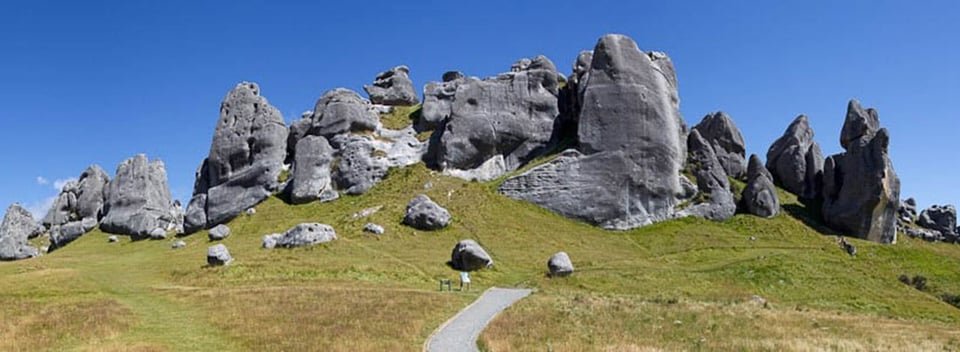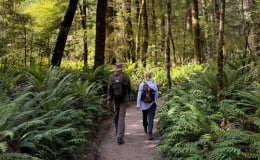
Arthur's Pass New Zealand

We know Arthur's Pass exceptionally well and we have spent many happy days here with guests on our New Zealand hiking tours. Located in the heart of the Southern Alps / Kā Tiritiri o te Moana, the high mountains, deep valleys and intricate braided rivers make it the perfect place for a hiking adventure. The Canterbury High Country is a truly stunning part of the South Island all year round – there’s adventure to be had for everyone. Just make sure to check Arthur's Pass weather before you go.

Welcome to the stunning Arthur's Pass, nestled in the Southern Alps.
Fun facts about Arthur's Pass, New Zealand
-
The name 'Bealey' is synonymous with the Arthur's Pass region and comes from an early superintendent of the Canterbury province, Samuel Bealey. In this area there is Mount Bealey, the Bealey Spur, the Bealey River, the Bealey Hotel and the original name for Arthur's Pass township was Bealey Flats.
-
On several of the hikes in Arthur's Pass, you’ll be treated to views of the permanent glaciers of Mount Rolleston. Mount Rolleston is the highest mountain in Arthur's Pass National Park at 2300m (7500ft).
-
Look out for the subalpine flora of Arthur's Pass, such as native daisies, buttercups (including the Mount Cook buttercup) and even the rare New Zealand edelweiss.

Our guide Chris showing guests around Arthur's Pass, New Zealand.
Best hikes in Arthur's Pass National Park
The Bealey Valley walk
The Bealey Valley is just five minutes past Arthur's Pass Village, accessed from a small car park on the gorgeously scenic road to Greymouth. For such a short hike, the views are spectacular! You start this walk in beautiful lush native beech forest; it’s real Lord of the Rings territory. As you cross the Bealey River bridge, it’s impossible not to marvel at the crystal-clear mountain waters cascading through the mini-gorge below – quite a sight when the river is in flood, too. After a short climb from the bridge, you’ll see an alpine wetland, a natural clearing in the forest with thick peat soil. From the clearing, you'll also get your first view of the permanent glaciers of Mount Rolleston. The mountains are all around and above you at this point, which is one of the highlights of this walk.
Devils Punchbowl Track
One of our favourite walks in Arthur's Pass is the Devils Punchbowl Track. The real prize here is the incredible 131m high waterfall. Wander through native beech forest admiring the birdlife that play overhead and feel truly at one with nature.
Otira Valley
Another great short walk option (one and a half hours) takes you through Otira Valley; it’s an excellent walk for enjoying native alpine flowers in summer. This graded track weaves through the alpine valley and tussock lands to the Otira River footbridge – this is the turnaround point.

The beautiful boulders of Castle Hill are spectacular to behold.
Best places to visit in Arthur's Pass
'The spiritual centre of the universe' Castle Hill / Kura Tawhiti
A popular stop along the Great Alpine Highway and the perfect contrast to the lush beech forests of Arthur's Pass, this part of the Canterbury High Country was once home to forest life, too. Over centuries, the bush has been cleared by both Māori and European settlers. The huge limestone boulders provided shelter for Māori food gathering and greenstone (pounamu) parties. Also named Kura Tawhiti, “the treasure from a distant land", this references the precious food source, the kumara (sweet potato), which was brought over and cultivated here. European history here goes back 150 years, as the first Canterbury settlers spread out from the plains into the High Country in search of land to graze their stock. The history of the neighbouring Castle Hill station is a whole encyclopaedia in itself.
The presence of the limestone rock formations is truly breathtaking – you'll see them from a long distance on your approach. You may even spot the extremely rare Castle Hill buttercup. These small, bright yellow flowers are fenced off to protect them. There's an easy flat walking track up to the boulders. It’s not difficult to imagine groups of early travellers resting under the rock overhangs and preparing a traditional feast (hangi) around the cooking fires. There's an energy here that is almost tangible. Upon his visit in 2002, the Dalai Lama christened Castle Hill as a "Spiritual Centre of the Universe".
Otira Lookout
Ten minutes past Arthur's Pass village is the Otira Viaduct Lookout, perched on the edge of the bluff just on the Western side of the Main Divide. It’s one pretty impressive road, especially when you take a look at the original route which was in use until relatively recently (1999). It certainly gives visitors an appreciation of how tough the early settlers had it! They would make their arduous journey to the West Coast in all weather, perched high on their stagecoach and traversing the rocky road in a generation that didn't pay too much heed to health and safety.
The view from the Lookout itself is of a very impressive feat of engineering – the Otira Viaduct – but another real drawcard here is that this is one of the best places anywhere in New Zealand to see our unique and very cheeky alpine parrot, the kea (Nestor Notablis). The world's only alpine parrot is only found in New Zealand's Southern Alps. We guarantee that this 'clown of the mountains' will bring a smile to your face. The kea is highly intelligent and rare, with an estimated 5000 remaining in the wild, and while you can never guarantee seeing wildlife anywhere, a visit will give you the best chance to see kea anywhere in New Zealand. They’re incredibly cheeky creatures so don't be surprised if they’re quite curious around you and your possessions!

The most scenic bridge you'll ever cross!
Best time to hike in Arthur's Pass National Park
New Zealand has a temperate climate, meaning it enjoys mild temperatures year-round. However, when dealing with the Southern Alps, the rules go out the window. If you are not an experienced tramper or mountaineer, we recommend only hiking in Arthurs Pass in spring through to autumn (October to April) when temperatures are at their highest.
Visiting Arthur's Pass with New Zealand Trails
On the first day of our World Heritage Walking Tour, you’ll go hiking in Arthur's Pass National Park. The Southern Alps run like a backbone down the South Island, dividing it east and west into two distinct regions, with Arthurs Pass serving as its gateway. This afternoon we’ll hike to the dramatic Devils Punchbowl Falls. With views up to Mount Rolleston and the permanent glaciers that carve their way down the mountain faces, this hike is a perfect introduction to your small-group walking tour and New Zealand's beauty.
If you want to find out more about the incredible 5-14 day hiking tours we run in New Zealand, you can request a free copy of our brochure here.







